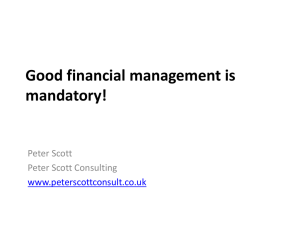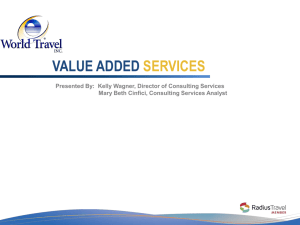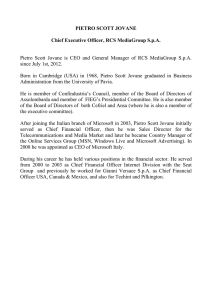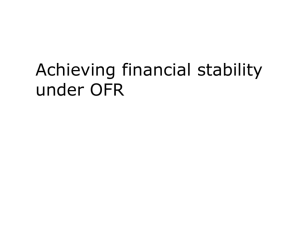Financial Stability Outcomes
advertisement
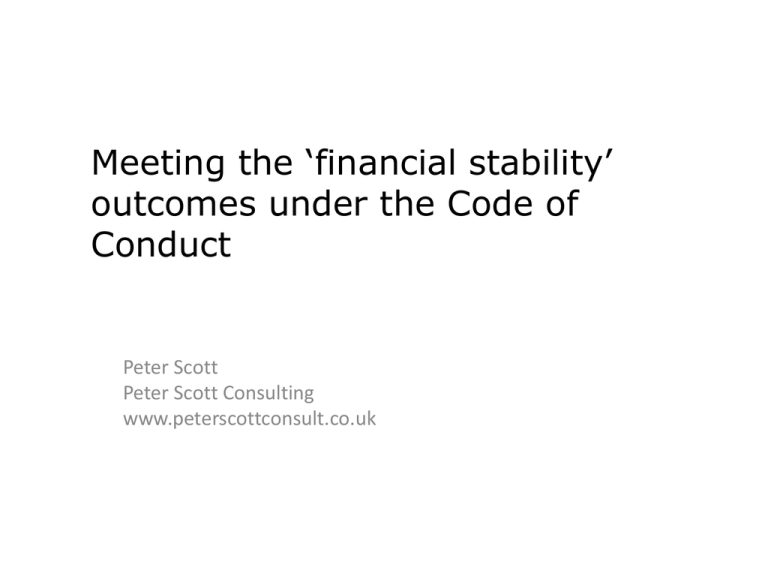
Meeting the ‘financial stability’ outcomes under the Code of Conduct Peter Scott Peter Scott Consulting www.peterscottconsult.co.uk The scope of our session today 1. Understanding the requirements of the Code 2. Identifying and dealing with your priority financial stability challenges 1. Understanding the requirements of the Code of Conduct regarding financial stability Good financial management has for the first time become a compliance requirement PETER SCOTT CONSULTING Some definitions of “stability” Firmly fixed or established; Not readily changing or fluctuating; Not easily destroyed or decomposed PETER SCOTT CONSULTING Outcome O (7.4) – Code of Conduct “you maintain systems and controls for monitoring the financial stability of your firm … and take steps to address issues identified” Do you have systems and controls for monitoring the financial stability of your firm? PETER SCOTT CONSULTING Acting in the following ways may tend to show that you have achieved these outcomes … IB (7.2) – controlling budgets, expenditure and cash flow IB (7.3) – identifying and monitoring financial …. risks including ….credit risks and exposure … PETER SCOTT CONSULTING Outcome O (10.3) “you must report to the SRA promptly any material changes to relevant information about you, including serious financial difficulty” PETER SCOTT CONSULTING ‘material’? Guidance Notes to Rule 8 Authorisation Rules provide, in relation to a failure to comply: (x) In considering whether a failure is “material” and therefore reportable, the COLP or COFA, as appropriate, will need to take account of various factors, such as: • the detriment, or risk of detriment, to clients • the extent of any risk of loss of confidence in the firm or in the provision of legal services • the scale of the issue • the overall impact on the firm, its clients and third parties. Acting in the following ways may tend to show that you have achieved these outcomes … IB (10.2) – actively monitoring your financial stability and viability in order to identify and mitigate any risks to the public IB (10.3) – notifying the SRA promptly of any indicators of serious financial difficulty ….. IB (10.4) – notifying the SRA promptly when you become aware that your business may not be financially viable to continue trading as a going concern ….. PETER SCOTT CONSULTING Examples from the Indicative Behaviours which may mean you are not achieving the financial stability outcomes IB (10.3) – notifying the SRA promptly of any indicators of serious financial difficulty, such as inability to pay your professional indemnity insurance premium, or rent or salaries, or breach of bank covenants IB (10.4) – notifying the SRA promptly when you become aware that your business may not be financially viable to continue trading as a going concern, for example because of difficult trading conditions, poor cash flow, increasing overheads, loss of managers or employees and / or loss of sources of revenue. ‘Going concern’? • Did the SRA intend to use ‘going concern’ in its technical accounting and audit sense and if so, what could be the implications of that for law firms? • If not intended to be used in its technical sense, then what does it mean? “Going concern” basis for an LLP or a company? “In preparing these financial statements the management team of the LLP have carefully considered the application of the going concern concept. The LLP meets its day to day working capital requirements through overdraft and practice management facilities which have all been renewed until [ ] The forecasts and projections of the business, taking account of reasonably foreseeable changes in trading performance, indicate that we should be able to operate comfortably within the level of our facilities. After making enquiries, the management team has a reasonable expectation that the LLP has adequate resources to continue in operational existence for a period of no less than 12 months from the date of signing the financial statements. Accordingly, we continue to adopt the going concern basis in preparing the annual report and financial statements” What should law firms be doing to make financial stability a PRIORITY? • Identify who should be responsible for financial management • Review financial measurement and reporting • Take control of cash management -‘Cash is king’ • Adopt ‘zero tolerance’ and ‘partner accountability’ • Put in place financial education and training • Establish an ‘audit trail’ PETER SCOTT CONSULTING Who should be responsible for financial stability? • • • • • FD? COFA? COLP? All owners of the business? All of the above? PETER SCOTT CONSULTING Review financial measurement and reporting “If you cannot measure it, then you will not be able to manage it” Are you measuring what matters? Cash is king - take control of your cash management Instructions Work W.I.P billing Cash payment PETER SCOTT CONSULTING Debtors Working capital • What is our firm’s working capital requirement? • What is our debt / equity ratio? • Are we able to consistently keep within our banking arrangements? • Is a cash call on partners likely to be required shortly? • Are we able to make distributions to partners from last year’s profits? • Will we be able to pay January’s tax bill? • Will we be able to repay capital to partners when they retire? PETER SCOTT CONSULTING Cash management priorities • taking instructions • Managing the WIP • Managing debtors Above all – manage partners! PETER SCOTT CONSULTING Adopt zero tolerance and partner accountability instead of this ….. “That’s a great idea …for the rest of you!” Establish an ‘audit trail’ “If you cannot demonstrate compliance we may take regulatory action” • • • • Measure what matters Report effectively Train your people Take advice if issues arise PETER SCOTT CONSULTING Take appropriate advice, act on it and document it NB – COLP’s and COFA’s responsibilities Outcome O (10.1) – you ensure you comply with all the reporting and notification requirements in the Handbook that apply to you Indicative behaviour IB (10.5) – notifying the SRA of any serious issues identified as a result of monitoring referred to in IB (10.1) and IB (10.2) and producing a plan for remedying issues that have been identified PETER SCOTT CONSULTING Put the squeeze on your business Any questions?
